We had a group of Science students from Zhenghua Secondary today. Initially, I was supposed to get 10 participants, but some how a few didn't turn up, and so I was left with only 7 of them in my group - Octopus. Jingkai was my assistant for the day. Managed to convinced him to become a guide after meeting him in one of the Team Seagrass monitoring sessions at Chek Jawa.
Hopefully I didn't scare him away after the first walk :)
It was a really hot and sunny day. And so I was glad that the students were very well-behaved, and didn't run around like wild monkeys at some of my previous walks. Or perhaps it's because they had to camp overnight in their school and most of them were too tired to ran around since they hardly got any sleep?
In any case, it was yet another wonderful trip.
We didn't spend much time at the mangrove area since we had to rush out to the reef area to catch the lowest tide, making only a few stops at the more important highlights, such as the common sea stars (Archaster typicus) area.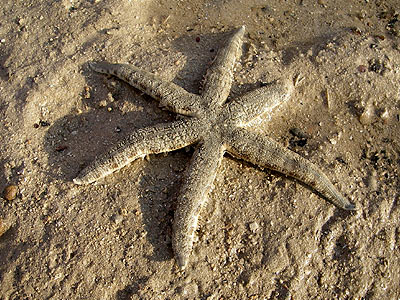
Luan Keng managed to find us a sea star with 6 arms. Perhaps it was really too hot, we didn't managed to find any more sea stars ourselves. Usually, we can find lots of them. You may notice that the one above has one of its arms shorter than the rest. Sea stars are really amazing animals, and they are able to regenerate lost limbs. However, it sometimes takes up to a year for the lost limbs to grow back, and in fact, if the central disc is damaged, it may just die.
And here a group shot taken with the sea star.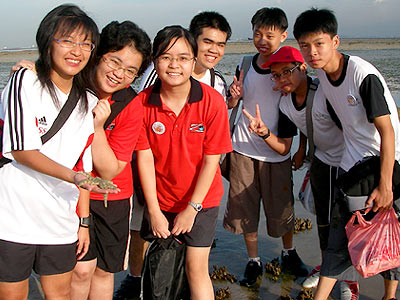
We also had to cross a seagrass lagoon. Seagrasses are flowering plants, and they are very important in the marine eco-system, because they are often used as nurseries by the marine animals. A seagrass lagoon has lots of shelter and food, and thus it's an excellent place to grow up! Currently, we have a group of volunteers called Team Seagrass to help monitor the seagrass in our waters. Read more about them at the Team Seagrass blog!
As we cross the seagrass lagoon, I was looking high and low for the resident synaptid sea cucumber which we normally see in the lagoon. However, I think I must be really tired that day, and couldn't find it. Thus, I decided to make another attempt to find it on the way back.
And as we stepped out of the seagrass lagoon, our hunter seeker had already found us two other species of sea cucumbers.
The above is a sandfish sea cucumber (Holothuria scabra). This sea cucumber is edible, but they must be properly treated before consumption, as they are poisonous.
The below is a thorny sea cucumber which we are not sure of the exact species.
As we walked into the coral rubble area, we found many hairy crabs (Family Pilumnidae).
Hairy crabs look so much like the places they live that it can quite difficult to spot them sometimes.
At the coral rubble, we also saw a scallop (Family Pectinidae).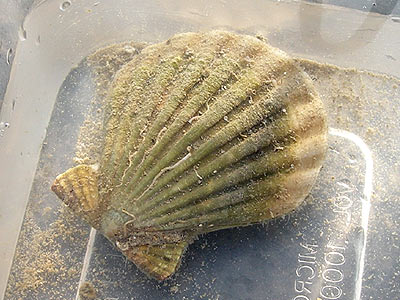
Like most other clams, scallops are filter feeders, meaning that when the tide is high, they open their shells a little and a current of water is generated through their shell. They will sieve out the food particles with their gills. When they are exposed during low tide, they will close up their shells.
We also found several different nudibranchs today. The name nudibranchs actually means "naked gills". They are actually slugs.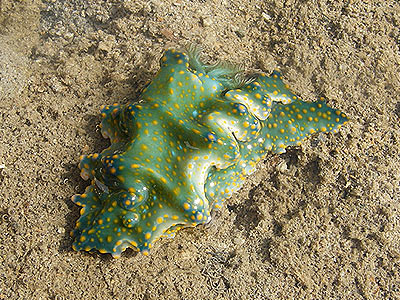
The above is the ceratosoma nudibranch (Ceratosoma sinuata). They appear to be in season these days, and we have been seeing them for the past few trips.
From top-left in clockwise direction, we have the polka dot nudibranch (Jorunna funebris), a marginated glossodoris nudibranch (Glossodoris atromarginata), a bohol nudibranch (Discodoris boholensis) and a pustolose phyllid nudibranch (Phyllidiella pustulosa).
While they move slowly and look soft, nudibranchs are not as defenseless as they look. Many of them can secrete chemicals that make them very distasteful or even toxic, while others harbour stinging cells from the animals they feed on.
Nudibranchs are hermaphrodites, and thus each slug has both male and female reproductive organs. They often fertilise each other when they mate. Sometimes, one may take on a male role, the other a female role.
Other than nudibranchs, we also found another slug - the onch (Onchidium sp.).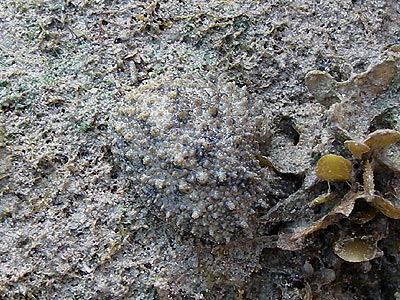
These slugs often blend in very well with the rocks, and graze on algae on the rocks during low tide. They have gills on their backsides to breathe air.
Towards the coral reef, we also found two knobbly sea stars (Protoreaster nodosus). Here's one of them.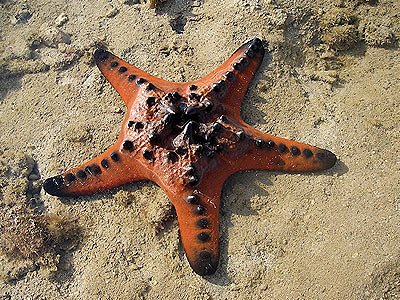
And those of you who have read my earlier blogs will know I always get my visitors to take a group photo with the knobbly sea star :)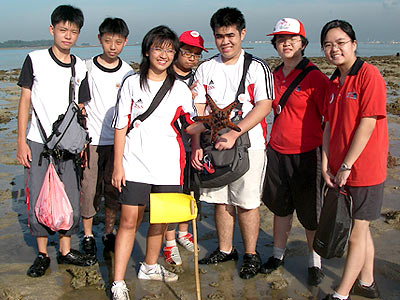
Like other sea stars, knobbly sea stars use seawater instead of blood to pump up their bodies, transfer nutrients to other parts of their body, and move their tube feet. Thus, it is stressful for sea stars to be left out of water for too long. This is why we always take a quick photo and release them into the water immediately.
At the coral reef, we also saw many different corals, including the hard corals (Order Scleractinia) below.
We saw many soft corals too, but I forgot to take any pictures. The reef area was also where we usually found the stonefish sea cucumber (Actinopyga lecanora).
Like most other sea cucumbers, the stonefish sea cucumber also breathes using its anus! To breathe, it pumps water in through its backside and up through an internal breathing system of branching tubes called respiratory trees. The water is then flushed out through the backside again. Related to the sea stars, they also get very stressful when they are out of sea water for too long.
We also saw a noble volute (Cymbiola nobilis).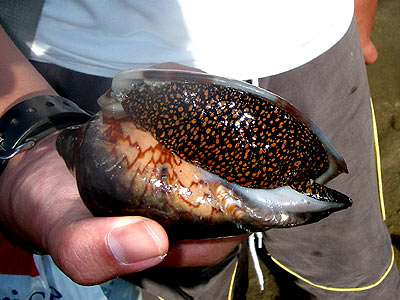
These huge snail normally feed on clams and other shells. It will seek out buried clams with its siphons and enclose the prey in its huge foot. It will wait until the exhausted clams open up to breathe, which can take several days! The volute will then sticks its proboscis in and eat the flesh of its prey with its radula (something like a tongue).
We also found this cute frogfish (Family Antennariidae). A frogfish has limb-like pectoral fins with an elbow-like joint, which allows it to sneak around slowly without its prey noticing it.
It also has a lure growing on top of its head, which sometimes it wriggles about to lure its prey, which are usually other fishes. Can you see the lure in the picture below?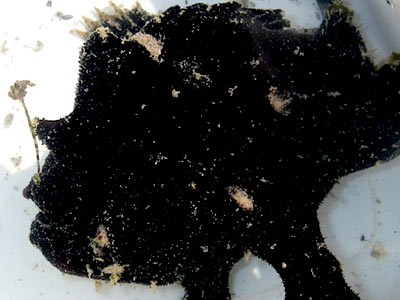
On the way back passing through the coral rubble area, I decided to help Luan Keng to pick up the hunter-seeker flags. And to my surprise, I realised that they found an upside-down jellyfish (Cassiopea sp.) and placed it at one of the flags after I had walked passed it earlier.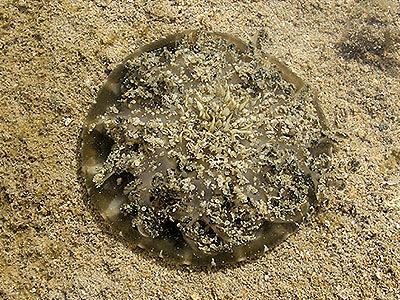
The above shows the jellyfish in its upside-down position. This jellyfish has symbiotic algae, mostly in its tentacles, which photosynthesises better with it being upside-down. Some of the food made by the algae will leak and get absorbed by the jellyfish.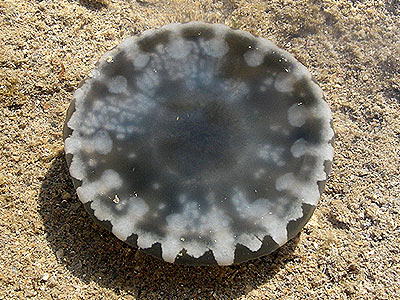
On the way back passing through the seagrass lagoon, Samson told me he saw the synaptid sea cucumber (Family Synaptidae) earlier. I tried looking for it, but missed it again. Good thing Samson remembered the spot he found it, and we finally get to see it.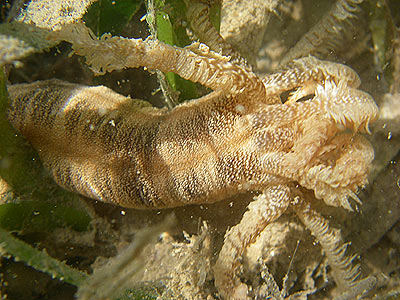
The above is a close-up of the sea cucumber's feeding tentacles lashing about to collect edible particles. When fully stretch, this sea cucumber may actually be about two metres long or even more!
We then headed towards the mangrove area, which I gave a quick introduction to the mangrove trees and the fiddler crabs, before heading back on NEA's bus to the main office for a video presentation about the landfill.
On the whole, although it's a really hot day, we still managed to see many interesting things. Thanks to the Zhenghua students for being so co-operative! :)
See also:
- More pictures on Samson's blog.
Saturday, March 24, 2007
A Sunny Semakau Walk on 24 March 2007
Subscribe to:
Post Comments (Atom)

3 comments:
Now I know what you guys meant when we missed that Frogfish. It is a real beau.
Unfortunately we spend too much time on the mangrove areas and missed couple of attraction. No worry, there will be next time.
Hey, Ron, i think i haven't tell you this.
i really miss you that day when i had to talk in the boat and NEA bus because of you weren't there!
However we found someone with the same potential as you, July! :)
Haha... So I guess next time I can just let July talk while I rest!
Post a Comment